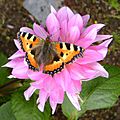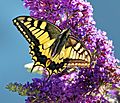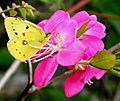Butterfly gardening facts for kids
Butterfly gardening is a special way of gardening where you create a perfect home for butterflies and even some moths. It's like building a welcoming neighborhood just for them! People do this to attract these beautiful insects, not just to visit, but also to lay their eggs. Besides planting flowers that butterflies love to eat, you can also build "butterfly houses." These houses might have sandy spots for "puddling," which is when butterflies drink water and get important minerals from damp soil. They also need fresh water to drink and sometimes enjoy snacks like rotten fruit.
-
A beautiful Danaus plexippus resting on a milkweed plant.
-
A Aglais urticae butterfly enjoying a Dahlia flower.
-
A Painted Lady butterfly on a bright Zinnia flower.
-
A Papilio machaon butterfly visiting a Buddleja plant.
Contents
Why Garden for Butterflies?
Creating a butterfly garden helps these amazing insects. Butterflies are important pollinators, which means they help plants make seeds and fruits. Many butterfly populations are shrinking, so giving them a safe place to live and find food is really helpful. It's also a fun way to learn about nature!
What Butterflies Need to Thrive
To make your garden a butterfly paradise, you need to think about their whole life cycle. Butterflies need different things at different stages.
Food for Adult Butterflies
Adult butterflies mostly drink nectar from flowers. Nectar is a sweet liquid that gives them energy. They are attracted to flowers that are brightly colored, like red, yellow, orange, pink, and purple. Flowers with flat tops or clusters of small flowers are often best, as they provide a good landing spot.
- Nectar plants: These are the flowers that adult butterflies feed on. Examples include butterfly bush, Zinnias, asters, and lavender.
- Rotten fruit: Some butterflies, especially those that are dark-colored, prefer to eat juices from rotting fruit. You can put out overripe bananas or oranges.
Host Plants for Caterpillars
Butterflies don't just need food for themselves; they also need specific plants to lay their eggs on. These are called "host plants." When the eggs hatch, the tiny caterpillars (butterfly larvae) eat the leaves of these plants. Each type of butterfly usually has one or a few specific host plants it will use.
- Milkweed: This is a famous host plant for the Monarch butterfly. Without milkweed, Monarchs cannot complete their life cycle.
- Parsley, dill, and fennel: These herbs are host plants for the Swallowtail butterfly.
- Passionflower: This plant is a host for the Gulf Fritillary butterfly.
Water and Minerals
Butterflies need water, just like us! They often get it from dew or nectar. But they also "puddle" to get important minerals.
- Puddling areas: You can create a puddling spot by filling a shallow dish with sand and keeping it damp. Butterflies will land on the wet sand and sip the mineral-rich water.
- Shallow water: A bird bath with some rocks for landing can also provide water.
Shelter and Sunlight
Butterflies need places to rest, warm up, and hide from bad weather or predators.
- Sunny spots: Butterflies are cold-blooded, so they need sunlight to warm their bodies before they can fly. Plant flowers in sunny areas.
- Shrubs and trees: These can offer shelter from wind and rain.
- Butterfly houses: These are small wooden boxes designed to give butterflies a place to hide, though their effectiveness is debated.
Planning Your Butterfly Garden
When you're ready to start your own butterfly garden, here are some tips:
- Choose native plants: Plants that naturally grow in your area are often the best choice. They are usually easier to care for and provide the right food for local butterflies.
- Plant in groups: Plant several of the same type of flower together. This creates a bigger patch of color that is easier for butterflies to spot.
- Avoid pesticides: Chemicals used to kill garden pests can also harm or kill butterflies and caterpillars. Try to garden organically.
- Provide continuous blooms: Choose different plants that bloom at different times of the year. This ensures there's always food available for butterflies from spring to fall.
Creating a butterfly garden is a rewarding project. You'll get to see beautiful butterflies up close and know you're helping nature!
Images for kids
-
A monarch waystation near the town of Berwyn Heights in Prince George's County, Maryland (June 2017)
-
Group of Lysandra coridon puddling
-
A monarch waystation in Bowling Green, Ohio, near Toledo (May 2019)
-
Hemaris fuciformis hovering at Scabiosa
-
Macroglossum stellatarum hovering at Verbena
-
Danaus chrysippus on Celosia
-
Aglais io on Zinnia
-
Gonepteryx rhamni, on Tagetes
-
Hyles lineata hovering at milkweed (Asclepias)
-
Two Aglais io and an Aglais urticae on Buddleja
-
Hemaris diffinis hovering at Buddleja
-
Papilio demoleus on Hibiscus
-
Heliconius cydno on Zingiberales
-
Colias erate on Rhododendron
-
Papilio demoleus on Rose
-
Hypolimnas bolina on Duranta
-
Graphium sarpedon on Lantana




































